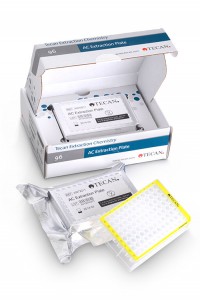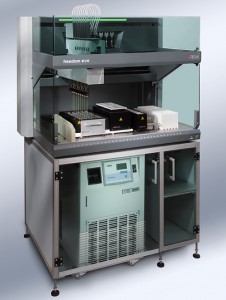Stand-alone and benchtop devices offer labs accessible automation solutions
By Gary Tufel
Automation has long been regarded as an important means for clinical laboratories to achieve greater efficiency, accuracy, standardization, quality, and patient safety. For a variety of reasons, however, some laboratories have in the past been slow to adopt automation as a broad strategy.
With increasing competition and demands for higher levels of performance, however, the need for automation has become more and more essential—even among labs that have been resistant until now. Meanwhile, the development of new generations of automated stand-alone and benchtop equipment has made lab automation a more and more viable option for labs of all sizes—and in many cases, a necessary option for labs seeking to remain competitive in today’s marketplace.
PRE- AND POSTANALYTICAL CHALLENGES
Laboratory automation expert and consultant Robin A. Felder, PhD, professor of pathology and associate director of clinical chemistry at the University of Virginia School of Medicine, says that most clinical laboratory errors—and more than half of all laboratory costs—are associated with preanalytical and postanalytical processing of specimens.
One laboratory study counted more than 15,000 errors per month among preanalytical processes alone.1 The laboratory’s errors were attributed to specimen mislabeling, misidentification, mis-sorting, improper routing, and pour-off (decanting) with the capability to have profound consequences on patient safety.
“The solution to these error challenges lies in task-targeted automation that can tirelessly perform routine extra-analytical functions such as sample inspection, sorting, centrifugation, transportation, and postanalytical processing,” Felder says.
Specimen Labeling. New technological solutions exist for the labeling and tracking of both patients and their specimens, says Felder. Many of the available systems use standard barcode-labeled wristbands that are read with handheld wireless barcode-reading devices. Increasingly, such reading devices may also be equipped to read new high-density (QR) codes that can carry comprehensive information. Barcoding systems are soon to be married to real-time locator systems that can record the time and location of specimen collection, and monitor a specimen’s position during subsequent transport, processing, and storage.
Sample Inspection. The human eye is remarkable in its ability to determine low concentrations of hemoglobin, lipid, and bilirubin in serum or plasma. “However, there is usually no agreement between what two individuals consider a threshold value where analytical interference becomes possible,” says Felder. “Paper labels can obscure the contents of the tube, making this determination impossible. Thus, spectrophotometric technologies have been created that allow for quantitative assessment of contamination in label-obscured specimens.”2 It is anticipated that commercial devices for such sample inspection will be at the front end of every accessioning station in the near future, Felder adds.
AUTOMATION’S ROLE
For many clinical laboratories, the expense and complexity of a total laboratory automation solution have been reason enough to avoid implementing automated systems of any kind. But current generations of automated equipment don’t require a commitment to total lab automation, and may include modules designed to automate only a portion of a laboratory’s operations. Modular automation of the accessioning process, for instance, has been termed “preanalytical automation.”
Modular automation promotes flexibility for matching hardware to the needs of the laboratory, and allows recombination of modules as the needs of the laboratory change. In Japan, for example, a product already in use in thousands of laboratories is a robot that automatically dispenses labeled tubes into a tray or bag dedicated to each patient’s blood testing order. This facilitates rapid throughput in phlebotomy areas.
Once tubes are delivered to the laboratory, modular automation devices can perform any combination of sorting, racking, centrifuging, and aliquoting into labeled daughter tubes to suit a wide range of laboratory needs and budgets. After sample analysis, postanalytical automation stations can automatically store specimens in a robot-equipped refrigerator for rapid and accurate recall of specimens for add-on, reflex, or repeat analysis.
Thus, for laboratories that have yet to make the expensive and time-consuming evolution to total laboratory automation, says Felder, there are task-targeted solutions that allow a gradual step-wise approach to gaining the efficiencies of laboratory automation.
INCREASED AUTOMATION
Driven by increasing test volumes, the requirements for processing higher-complexity assays, and the need to reduce turnaround time, today’s clinical laboratories are increasingly adopting flexible benchtop automation solutions. “We are definitely seeing movement in the market for automation,” says Anne Tate, senior product manager for Sysmex America, Lincolnshire, Ill.
“The consolidation of the laboratory market over the last years has accelerated this change by aggregating test volumes of esoteric tests that are not available on closed clinical platforms, and requiring scale effects that are nonlinear to human capital,” says Rohit Shroff, product manager for Tecan Schweiz AG, Männedorf, Switzerland. “Clinical laboratories are adopting flexible benchtop automation tailored toward their needs of today, but adaptable to their needs of tomorrow,” he says.
In clinical laboratories, microplate-based immunoassays are commonly used to process tests that are not available on closed, random-access platforms, Shroff notes. With the ongoing consolidation among laboratories, however, the use of such tests is reaching volumes that require automation. As immunoassays represent a relatively standardized workflow, laboratories look for flexibility in throughput. From stand-alone washers and readers to fully automated workstations, solutions are available to match a clinical laboratory’s assay and throughput requirements.

The AC extraction plate by Tecan Schweiz AG simplifies the sample-preparation workflow for assays performed using liquid chromatography mass spectrometry.
“In the microplate-based segment of the immunoassay market, labs have an increasing desire to source both the assays and their automation from one vendor, so that there is a single point of contact for the result,” says Shroff. “To meet this market requirement, Tecan has acquired IBL International, a provider of immunoassay kits.”
While immunoassays are a standard technology in the clinical lab, limitations driven by cross-reactivity, lot-to-lot variability, and the desire for quantification have led to the emergence of alternatives, prominently including specimen analysis using liquid chromatography mass spectrometry (LC-MS). Toxicology, clinical biochemistry, and endocrinology labs have been especially quick to adopt LC-MS technology. In turn, the increasing volume of testing performed via LC-MS is driving the adoption of automation for sample preparation.
“Automating sample-preparation methods such as solid-phase extraction or sample accessioning and dilution can enable clinical labs to make the most of their investments in LC-MS, making it possible to acquire reliable, reproducible, and traceable data with the desired speed,” says Shroff.

The configurable Freedom EVO 100 by Tecan Schweiz AG, shown with integrated GenePaint modules for automated in situ hybridization.
Based on the company’s Freedom EVO platforms, Tecan provides a range of liquid-handling workstations dedicated to automating LC-MS sample preparation. In addition, with a view toward providing holistic solutions to customers, Tecan has introduced the AC extraction plate, which allows for extraction of small molecules following a simple, automation-friendly workflow, says Shroff.
“As automation in the clinical laboratory increases, Tecan continues to work with individual labs to identify their needs and provide solutions in all aspects of the workflow—preanalytics, analytics, and postanalytics,” he adds.
Tate notes that Sysmex is the leader among manufacturers of slide-maker stainers, and that these products are moving the market toward automation. “In addition, stand-alone automation certainly has its place,” she says, “and when you look at products such as Sysmex’s XN-3000 automated hematology system and DI-60 integrated slide-processing system, it’s definitely becoming more and more accepted throughout the industry.
“The use of automation is also being seen in smaller labs, and we believe there is going to be more automation in the future to help laboratories save time and have less of a hands-on approach.” Tate adds that her company offers unique hematology automation solutions for all types of testing laboratories. These solutions provide operational efficiencies for automated testing, integrated intelligent smear preparation, automated smear review, and reagent management, she says.
Specifically, XN-Series automated hematology analyzers enable any laboratory to implement advanced clinical and operational capabilities, regardless of the lab’s size or throughput. The XN’s scalable, series-wide compact design delivers a small footprint that optimizes speed and functionality, says Tate, and an expanded and unique clinical parameter menu supports evolving healthcare needs. All XN-Series configurations use identical reagents, and offer identical QC software and analytical capabilities.
The XN’s configurable modularity supports the lab’s workflow needs. Also, the instruments’ exclusive concentrated reagent handling system reduces downtime, the physical strain of reagent handling, and storage space requirements.

The Sysmex XN-3000 combines the company’s XN-2000 automated hematology system (right) with the newest member of the series: the DI-60 integrated slide-processing system.
Also part of the XN-Series, the Sysmex XN-2000 and XN-3000 automated hematology systems provide optimal throughput with workload balancing. Additionally, says Tate, software intelligence delivered onboard or via optional Sysmex WAM middleware provides basic and comprehensive decision support to further enhance operational efficiencies.
The Sysmex XN-9000 automated hematology system is a scalable automation platform coupled with tube sorting and archiving, plus automated HbA1c testing via Bio-Rad’s Variant II Turbo Link HbA1c.
The most recent innovation added to the XN-Series, the Sysmex DI-60 integrated slide-processing system, offers automation and integration of smear review. Such an instrument can improve turnaround time and consistency in the quality of smears, says Tate.
INCREASING DEMAND FOR LAB AUTOMATION
As laboratories continue to experience an increasing demand for the rapid delivery of accurate and reliable test results, the need for laboratory automation will only increase, notes Franz Walt, CEO of the chemistry, immunoassay, automation, diagnostics, and IT business unit at Siemens Healthcare Diagnostics, Tarrytown, NY.
“As a worldwide leader in automation, Siemens Healthcare Diagnostics works closely with customers to help ensure that they get a solution suited to their needs,” says Walt. “For those customers—such as satellite and low- to mid-volume labs that are often faced with laboratory size and budgetary constraints—a track-based automation solution may not be the right approach.”
Instead, says Walt, an intelligent sample-management system that connects multiple systems through a single robotic interface—such as Siemens’ VersaCell X3 solution—may be the best option to help these customers enhance efficiencies and streamline operations.
Siemens’ VersaCell X3 system is an advanced robotic solution that offers many of the benefits of a track-based system without the related budget and space considerations. To name a few, features of the VersaCell X3 solution include intelligent, independent sample management; a single robotic interface that automates sorting and supports access to connected systems; and advanced stat management.

The VersaCell X3 solution by Siemens Healthcare Diagnostics uses robotics with dynamic stat management to optimize the mix of chemistry or immunoassay analytics.
“The latest model of our VersaCell system, the VersaCell X3 solution, maintains a small footprint while connecting up to three Siemens systems to meet the customized immunoassay and chemistry menu and productivity needs of different labs,” says Walt. “In line with the Siemens automation philosophy, this solution helps laboratories to reduce operator sample handling and drive predictable turnaround times.
“A centralized screen on our VersaCell X3 solution provides consolidated, single-operator access to all connected analyzers. Also, customers can achieve further data consolidation through a connection to Siemens’s CentraLink data-management system,” Walt adds.
LEAN INITIATIVES TO SUSTAIN LAB IMPROVEMENT
“Reducing variation and delivering quality, timely results are virtues that laboratories constantly strive to achieve,” says Joe Ross, senior manager for automation and clinical information systems at Beckman Coulter Diagnostics, Brea, Calif. The preanalytical portions of a lab can account for more than 65% of its areas associated with manual processes, where variations in the testing process often arise. In an environment saturated with total lab automation solutions to help improve quality, says Ross, labs constrained by size and budget need to look for solutions to help reduce variation in manual processes—including both physical and decision-making processes.
Utilizing Lean processing initiatives, which are designed to eliminate waste and improve efficiency in various processes and industries, is the first step toward identifying key areas for improvement, says Ross. In order to successfully sustain those improvements, labs needs some level of technology to help them.

The AutoMate 1200 by Beckman Coulter automates receipt, decapping, aliquoting, sorting, and archiving of patient specimens.
Standardizing Workflow. “Workflow standardization can be achieved using stand-alone automation solutions. These solutions should have the capacity to receive, decap, aliquot, sort, and archive specimens—performing all of the operations where processing errors and variation can occur,” says Ross. One example of such a solution is Beckman Coulter’s AutoMate 1200/2500 series of stand-alone automation systems. These systems help reduce manual processes, and allow for a consistent flow of specimens to their end destination, he says.
Informatics can be deployed to further ensure success, while enhancing this automated process. The informatics system is used to provide a detailed, rules-based approach, ensuring that each specimen is treated equally, based on the laboratory’s standard operating procedures. Utilizing middleware, postanalytical standardization can be streamlined by reducing manual interpretation of results, says Ross.
Maintaining Improvements. While quality, standardization, and the efficiencies produced by Lean initiatives are the ultimate objectives, maintaining those improvements tends to be laboratories’ greatest challenge. Once achieved, keeping up a lab’s established level of standardization is critical for eliminating variability and streamlining the workflow. “The capstone for improving such processes is to deploy methods for measuring improvements toward the laboratory’s goals, and then monitoring them in order to maintain success,” says Ross.
Laboratory analysis tools, such as hc1.com from Beckman Coulter, can provide real-time measurements that enable labs to react quickly to pertinent outlying specimens or deviations from standard processes. In turn, such tools make it possible for labs to sustain Lean initiatives by providing an easily accessible base of tools that can track key performance indicators.
While there are many avenues a laboratory can follow to tackle preanalytical variation, defining key objectives and measurable goals is the foundation to success, says Ross. Once the goals have been defined, it’s a matter of finding the right technology to help attain them.
Gary Tufel is a contributing writer for CLP. For further information, contact CLP chief editor Steve Halasey via [email protected].
REFERENCES
1. Holman JW, Mifflin TE, Demers LM, Felder RA. Clinical evaluation of an automated preanalytical robotic workstation at two locations. Clin Chem. 2002;48(3):540–548.
2. Stickle DF, Moss PF, Markin RS. An approach to automated detection of hemolysis in capped, labeled specimens without sampling using a fiber optics charge-coupled device (CCD) array spectrophotometer. Presentation abstract no. 383. Clin Chem. 2001;47(6 suppl): A116–A117.










